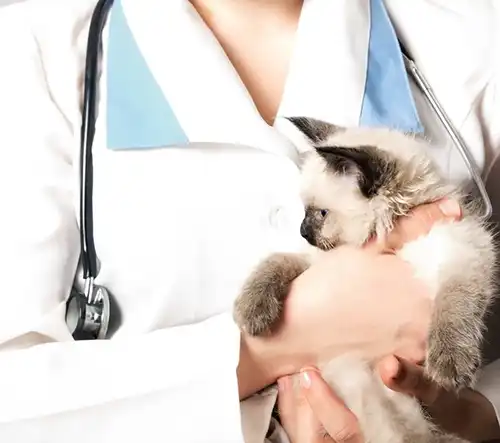Laser therapy is one of the therapies we are proud to provide at Aloha Animal Hospital. While this may sound like something out of a science fiction film, lasers have been used in human and veterinary medicine for decades. It has made several of our furry patients feel better! In this article, a veterinarian from Las Vegas, NV covers veterinary laser therapy and answers some fundamental questions.
Does Veterinary Laser Therapy Really Work?
Yes! In fact, that may be the most important thing about it. Laser therapy not only works, but it can provide some amazing results! We love witnessing a stiff elderly dog regain its energy or simply rest as their pain is relieved. At the end of the day, we all want to keep our pets as healthy and comfortable as possible.
However, it may not be suitable for all pets. Treatment choices should always be assessed on an individual basis. Please contact us if you believe your four-legged companion would benefit. It’s always a good idea to learn more!
What is Veterinary Laser Therapy?
Laser therapy, as the name implies, is a form of physical therapy for pets that employs lasers. This may sound alarming, but the lasers used are light-based and do not cut or puncture the skin.
Let us throw some light on how lasers work. The technology operates by using light. In fact, the term ‘Laser’ stands for Light Amplification of Stimulated Emission of Radiation.
They may produce three types of light beams. First, we have monochromatic, which has only one wavelength. Then there’s coherent electromagnetic radiation. Finally, there’s collimated. This type of laser generates photons that are focused into a single beam of light.
Coherent and collimated lasers can be focused with high accuracy. This is where the term “laser focus” originated.
Now that we’ve identified the many types of lasers, we may classify them into categories. There are four variations. Class 1 would be similar to what you see on barcode readers in grocery stores. They have the lowest strength. Class 4 is the most powerful, and it is capable of making cuts. Class 3 is commonly used for pet therapy. It’s also often known as Cold Laser.
That, of course, is the short version. For further information, please see your Southwest Las Vegas, NV veterinarian.
How Does Veterinary Laser Therapy Really Work?
The photobiostimulation theory underpins laser therapy. The laser’s light can get deep into cells. This causes a chemical reaction, or rather, a series of them. These include increasing the production of endorphins, the body’s natural painkillers; improving circulation; lowering inflammation; increasing healing time; reducing inflammation and pain; and aiding bone mending.
The therapy’s effects and advantages are typically cumulative. This means that your pet’s condition will improve even after several treatments.
What Health Conditions Can Laser Therapy Treat in Pets?
One of the reasons we value laser therapy is its adaptability. It is widely used to treat dogs suffering from arthritis, hip dysplasia, or other bone/joint diseases. However, it is also used to treat a wide range of other conditions.
This list consists of the following:
- Osteoarthritis
- Intravertebral Disc Disease
- Lick Granuloma
- Cellulitis
- Arthritis and Ear Problems
- Sprains and Strains
- Hip Dysplasia.
- Muscle atrophy
- Skin problems.
- Nerve Issues
- Tendon and Ligament Problems.
- Injuries
- Abnormalities of the muscle and skeleton
- Gingivitis
- Degenerative Joint Disease.
- Dental procedures
- Inflammation
- Inflammatory bowel disease
- Bone fractures
As you can see, this can be an effective treatment for a variety of illnesses. For further information, contact your veterinarian.
What Are the Advantages of Laser Therapy?
Laser therapy has various distinct and amazing advantages, many of which make it an outstanding alternative for treating our canine companions. But what are the benefits of this rapidly developing treatment?
Let’s have a look at some of the major ones:
Personalized Treatment Plan Each of our patients is unique, and so should be their treatments. Laser therapy can be utilized in a range of treatment options. For example, it may aid in one dog’s recovery after surgery while benefiting another by reducing inflammation. This frequently allows us to provide the most robust and effective solutions while minimizing discomfort for our patients. We can also make modifications as needed.
It’s Completely Painless One of the most essential concerns and challenges when it comes to animal care is the pet’s comfort. Laser therapy is extremely effective in this area. It’s absolutely painless! In fact, many pets seem to like the treatments. Our patients commonly exhibit symptoms of calmness during their sessions. Some people fall asleep!
No Incision Needed Laser therapy is a non-invasive treatment option. No incisions are necessary. In fact, it frequently accelerates the healing process.
No Known Side Effects Laser therapy is extremely safe. There are no known harmful effects. That alone is a big plus!
Short Sessions – Easy To Schedule Laser therapy sessions are typically short. Most appointments last about 20 minutes or less. With so many people juggling demanding schedules these days, this is a welcome addition.
No Anesthesia Required No anesthesia is necessary. While anesthetics are generally safe, they should not be taken excessively. A soothing medication may be given to a pet prior to therapy, but it is not necessary to sedate them.
No Recovery Time Necessary There is no healing time. Laser therapy’s painlessness and non-invasiveness are amazing in and of itself. However, all of these factors combine to provide an additional amazing benefit. Your pet will not require any special care, with the exception of a snooze and some extra forehead scritches. (A new toy or a nice treat is not required, but would be appreciated.)
How Often Should Pets Have Laser Therapy?
The specific treatment plan for your pet will be defined by the problem for which he is being seen. If your pet has an acute condition, daily treatments may be most effective, particularly if he or she is in pain. Another dog may perform better with two or three weekly lessons.
In general, the sessions would wind down after the desired effect was achieved. Your veterinarian will monitor the results and adjust the instructions as needed.
Will My Pet Get Tired After Laser Therapy?
It is fairly uncommon for our pets to become weary after his treatments. There are various plausible explanations for this. The most important benefit would be reduced pain and stiffness. That in itself can be really relaxing. The relief can also help to induce deep, restorative sleep. Make sure your pet has a nice bed to sleep on.
Conclusion: Laser therapy is a painless, non-invasive treatment that can help pets with a variety of health issues. While it is most typically used to help arthritic dogs, it is highly flexible and may be used to treat a wide range of ailments.
Contact Our Southwest Las Vegas, NV Veterinary Clinic To Make An Appointment.
Do you think your pet would benefit from laser therapy? Do you want to learn more about it? Please do not hesitate to contact us at the Pet Hospital. As your pet hospital, we’re here to help!






!Social Media Icons